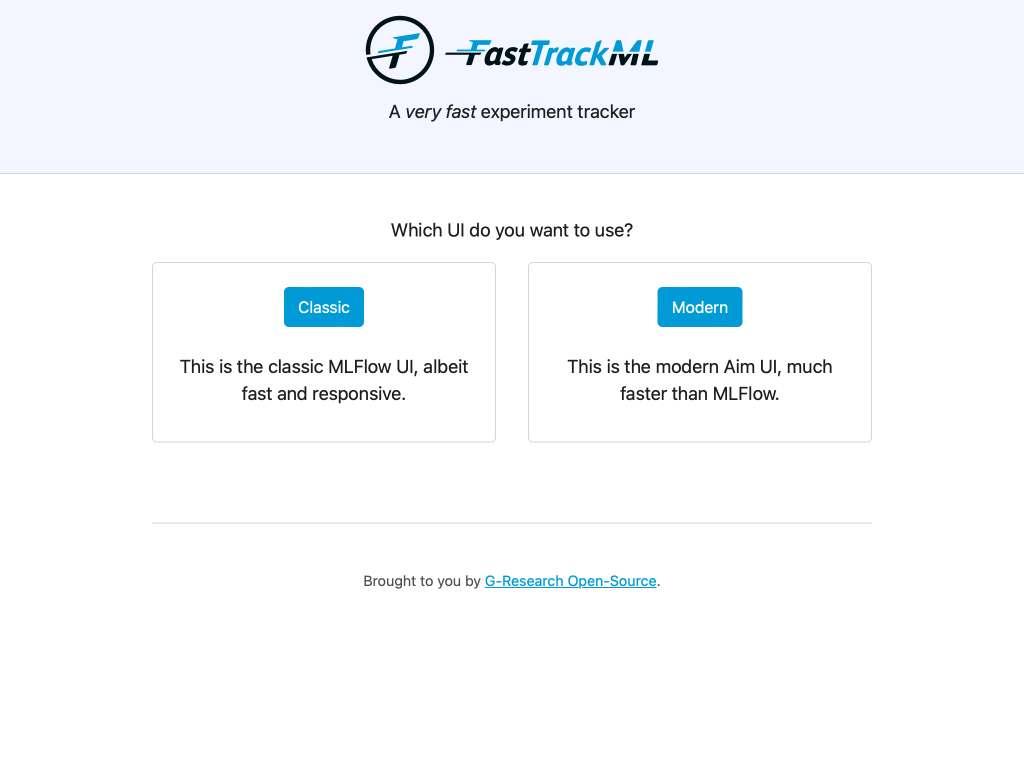Ecosyste.ms: Awesome
An open API service indexing awesome lists of open source software.
https://github.com/g-research/fasttrackml
Experiment tracking server focused on speed and scalability
https://github.com/g-research/fasttrackml
ai apache-spark data-science data-visualization experiment-tracking machine-learning metadata metadata-tracking metrics ml mlflow mlflow-tracking-server mlops pytorch tensorboard tensorflow visualization
Last synced: 2 days ago
JSON representation
Experiment tracking server focused on speed and scalability
- Host: GitHub
- URL: https://github.com/g-research/fasttrackml
- Owner: G-Research
- License: apache-2.0
- Created: 2023-03-30T15:46:08.000Z (almost 2 years ago)
- Default Branch: main
- Last Pushed: 2024-10-29T03:21:42.000Z (3 months ago)
- Last Synced: 2024-10-29T17:27:20.049Z (3 months ago)
- Topics: ai, apache-spark, data-science, data-visualization, experiment-tracking, machine-learning, metadata, metadata-tracking, metrics, ml, mlflow, mlflow-tracking-server, mlops, pytorch, tensorboard, tensorflow, visualization
- Language: Go
- Homepage: https://fasttrackml.io/
- Size: 5.85 MB
- Stars: 98
- Watchers: 14
- Forks: 19
- Open Issues: 71
-
Metadata Files:
- Readme: README.md
- License: LICENSE
Awesome Lists containing this project
README
[](https://fasttrackml.io/)
# _FastTrackML_
FastTrackML is an API for logging parameters and metrics when running
machine learning code, and it is a UI for visualizing the result. The
API is a drop-in replacement for MLflow's tracking server, and it
ships with the visualization UI of both MLflow and Aim.
As the name implies, the emphasis is on speed -- fast logging, fast
retrieval.
### Quickstart
#### Run the tracking server
> [!NOTE]
> For the full guide, see our [quickstart guide](https://github.com/G-Research/fasttrackml/blob/main/docs/quickstart.md).
FastTrackML can be installed and run with `pip`:
```bash
pip install fasttrackml
fml server
```
Alternatively, you can run it within a container with
[Docker](https://docs.docker.com/get-docker/):
```bash
docker run --rm -p 5000:5000 -ti gresearch/fasttrackml
```
Verify that you can see the UI by navigating to http://localhost:5000/.

For more info, `--help` is your friend!
#### Track your experiments
Install the MLflow Python package:
```bash
pip install mlflow-skinny
```
Here is an elementary example Python script:
```python
import mlflow
import random
# Set the tracking URI to the FastTrackML server
mlflow.set_tracking_uri("http://localhost:5000")
# Set the experiment name
mlflow.set_experiment("my-first-experiment")
# Start a new run
with mlflow.start_run():
# Log a parameter
mlflow.log_param("param1", random.randint(0, 100))
# Log a metric
mlflow.log_metric("foo", random.random())
# metrics can be updated throughout the run
mlflow.log_metric("foo", random.random() + 1)
mlflow.log_metric("foo", random.random() + 2)
```
### Developer
FastTrackML can be built and tested within a
[dev container](https://containers.dev). This is the recommended way as the
whole environment comes preconfigured with all the dependencies (Go SDK,
Postgres, Minio, etc.) and settings (formatting, linting, extensions, etc.) to
get started instantly.
#### GitHub Codespaces
If you have a GitHub account, you can simply open FastTrackML in a new GitHub
Codespace by clicking on the green "Code" button at the top of this page.
You can build, run, and attach the debugger by simply pressing F5. The unit
tests can be run from the Test Explorer on the left. There are also many targets
within the `Makefile` that can be used (e.g. `build`, `run`, `test-go-unit`).
#### Visual Studio Code
If you want to work locally in
[Visual Studio Code](https://code.visualstudio.com), all you need is to have
[Docker](https://docs.docker.com/get-docker/) and the
[Dev Containers extension](https://marketplace.visualstudio.com/items?itemName=ms-vscode-remote.remote-containers)
installed.
Simply open up your copy of FastTrackML in VS Code and click "Reopen in
container" when prompted. Once the project has been opened, you can follow the
GitHub Codespaces instructions above.
> [!IMPORTANT]
> Note that on MacOS, port 5000 is already occupied, so some
[adjustments](https://apple.stackexchange.com/a/431164) are necessary.
#### CLI
If the CLI is how you roll, then you can install the
[Dev Container CLI](https://github.com/devcontainers/cli) tool and follow the
instruction below.
CLI instructions
> [!WARNING]
> This setup is not recommended or supported. Here be dragons!
You will need to edit the `.devcontainer/docker-compose.yml` file and uncomment
the `services.db.ports` section to expose the ports to the host. You will also
need to add `FML_LISTEN_ADDRESS=:5000` to `.devcontainer/.env`.
You can then issue the following command in your copy of FastTrackML to get up
and running:
```bash
devcontainer up
```
Assuming you cloned the repo into a directory named `fasttrackml` and did not
fiddle with the dev container config, you can enter the dev container with:
```bash
docker compose --project-name fasttrackml_devcontainer exec --user vscode --workdir /workspaces/fasttrackml app zsh
```
If any of these is not true, here is how to render a command tailored to your
setup (it requires [`jq`](https://jqlang.github.io/jq/download/) to be
installed):
```bash
devcontainer up | tail -n1 | jq -r '"docker compose --project-name \(.composeProjectName) exec --user \(.remoteUser) --workdir \(.remoteWorkspaceFolder) app zsh"'
```
Once in the dev container, use your favorite text editor and `Makefile` targets:
```bash
vscode ➜ /workspaces/fasttrackml (main) $ vi main.go
vscode ➜ /workspaces/fasttrackml (main) $ emacs .
vscode ➜ /workspaces/fasttrackml (main) $ make run
```
### License
Copyright 2022-2023 G-Research
Copyright 2019-2022 Aimhub, Inc.
Copyright 2018 Databricks, Inc.
Licensed under the Apache License, Version 2.0 (the "License"); you may not use
these files except in compliance with the License.
You may obtain a copy of the License at
http://www.apache.org/licenses/LICENSE-2.0
Unless required by applicable law or agreed to in writing, software
distributed under the License is distributed on an "AS IS" BASIS,
WITHOUT WARRANTIES OR CONDITIONS OF ANY KIND, either express or implied.